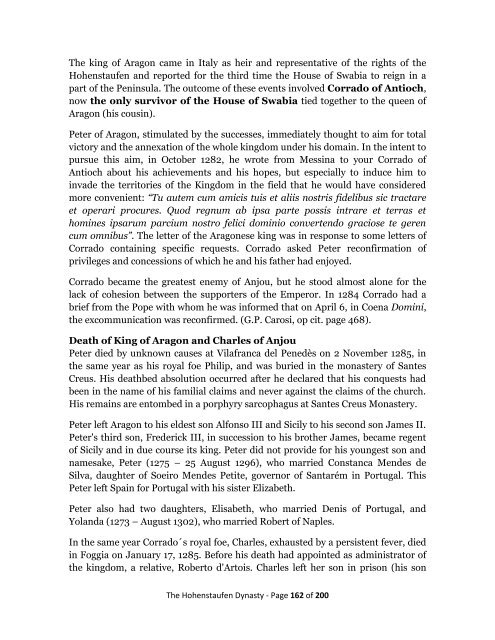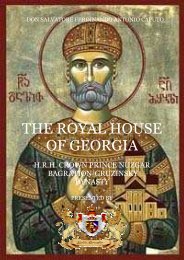here - Nobility Associations
here - Nobility Associations
here - Nobility Associations
Create successful ePaper yourself
Turn your PDF publications into a flip-book with our unique Google optimized e-Paper software.
The king of Aragon came in Italy as heir and representative of the rights of the<br />
Hohenstaufen and reported for the third time the House of Swabia to reign in a<br />
part of the Peninsula. The outcome of these events involved Corrado of Antioch,<br />
now the only survivor of the House of Swabia tied together to the queen of<br />
Aragon (his cousin).<br />
Peter of Aragon, stimulated by the successes, immediately thought to aim for total<br />
victory and the annexation of the whole kingdom under his domain. In the intent to<br />
pursue this aim, in October 1282, he wrote from Messina to your Corrado of<br />
Antioch about his achievements and his hopes, but especially to induce him to<br />
invade the territories of the Kingdom in the field that he would have considered<br />
more convenient: “Tu autem cum amicis tuis et aliis nostris fidelibus sic tractare<br />
et operari procures. Quod regnum ab ipsa parte possis intrare et terras et<br />
homines ipsarum parcium nostro felici dominio convertendo graciose te geren<br />
cum omnibus”. The letter of the Aragonese king was in response to some letters of<br />
Corrado containing specific requests. Corrado asked Peter reconfirmation of<br />
privileges and concessions of which he and his father had enjoyed.<br />
Corrado became the greatest enemy of Anjou, but he stood almost alone for the<br />
lack of cohesion between the supporters of the Emperor. In 1284 Corrado had a<br />
brief from the Pope with whom he was informed that on April 6, in Coena Domini,<br />
the excommunication was reconfirmed. (G.P. Carosi, op cit. page 468).<br />
Death of King of Aragon and Charles of Anjou<br />
Peter died by unknown causes at Vilafranca del Penedès on 2 November 1285, in<br />
the same year as his royal foe Philip, and was buried in the monastery of Santes<br />
Creus. His deathbed absolution occurred after he declared that his conquests had<br />
been in the name of his familial claims and never against the claims of the church.<br />
His remains are entombed in a porphyry sarcophagus at Santes Creus Monastery.<br />
Peter left Aragon to his eldest son Alfonso III and Sicily to his second son James II.<br />
Peter's third son, Frederick III, in succession to his brother James, became regent<br />
of Sicily and in due course its king. Peter did not provide for his youngest son and<br />
namesake, Peter (1275 – 25 August 1296), who married Constanca Mendes de<br />
Silva, daughter of Soeiro Mendes Petite, governor of Santarém in Portugal. This<br />
Peter left Spain for Portugal with his sister Elizabeth.<br />
Peter also had two daughters, Elisabeth, who married Denis of Portugal, and<br />
Yolanda (1273 – August 1302), who married Robert of Naples.<br />
In the same year Corrado´s royal foe, Charles, exhausted by a persistent fever, died<br />
in Foggia on January 17, 1285. Before his death had appointed as administrator of<br />
the kingdom, a relative, Roberto d'Artois. Charles left her son in prison (his son<br />
The Hohenstaufen Dynasty - Page 162 of 200



